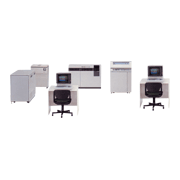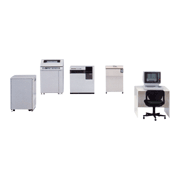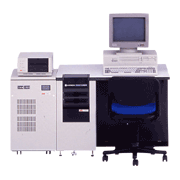In order to meet the need for versatile OA systems, the HITAC L Series (announced in 1983) was equipped with features such as: comprehensive Japanese language document processing, the ability to connect to various types of OA equipment, and an easy-to-use database.
The compact design used world-class ultra high-density VLSI (Very Large Scale Integration) with 20,000 gates/chip for logic circuits. These machines used a 100V power supply, and did not require special air conditioning equipment or free access. The setup area for the lower-end L-450 was 0.33 square meter and was on a par with an end table desk. The L-470 was a high-end machine in this series.
The L-400 Series X Model, announced in 1985, went a step beyond OA designed simply for business processing, and functioned as OA enabling end users to actively use information.
More precisely, end-user departments with either Personal Workstation 2020 or Creative Workstation 2050 machines could search and retrieve, with a one-touch operation, data stored on HITAC L-400 series machines. And HITAC L-400 series machines could store and search data created or processed at end-user departments.
Greater compactness was achieved by using ultra high-density VLSI with 20,000 gates/chip. There were four models -- the L-450X desk-type, L-450X, L-470X and L-490X -- and field upgrading to higher-end models could be done at the setup location.
The L-490X CPU’s performance was about 2.7-times that of the L-450X, and the L-470X CPU’s performance was about 2.1-times that of the L-450X. The L-490X had a maximum main memory capacity of 12 megabytes, the L-470X, eight megabytes and the L-450X and the L-450X desk-type model, four megabytes. The L-490X’s maximum disk capacity was 5.4 gigabytes, the L-470X, 3.4 gigabytes, the L-450X, one gigabyte, and the L-450X desk-type model, 0.5 gigabytes. In terms of floor space, the L-450X processor required 0.32 square meters, equivalent to a drawer unit, and when combined with a disk-drive unit, a workstation, and a printer, it took up about 7 square meters. Furthermore, it connected to a regular commercial power supply and did not require any special air-conditioning or free-access space.




